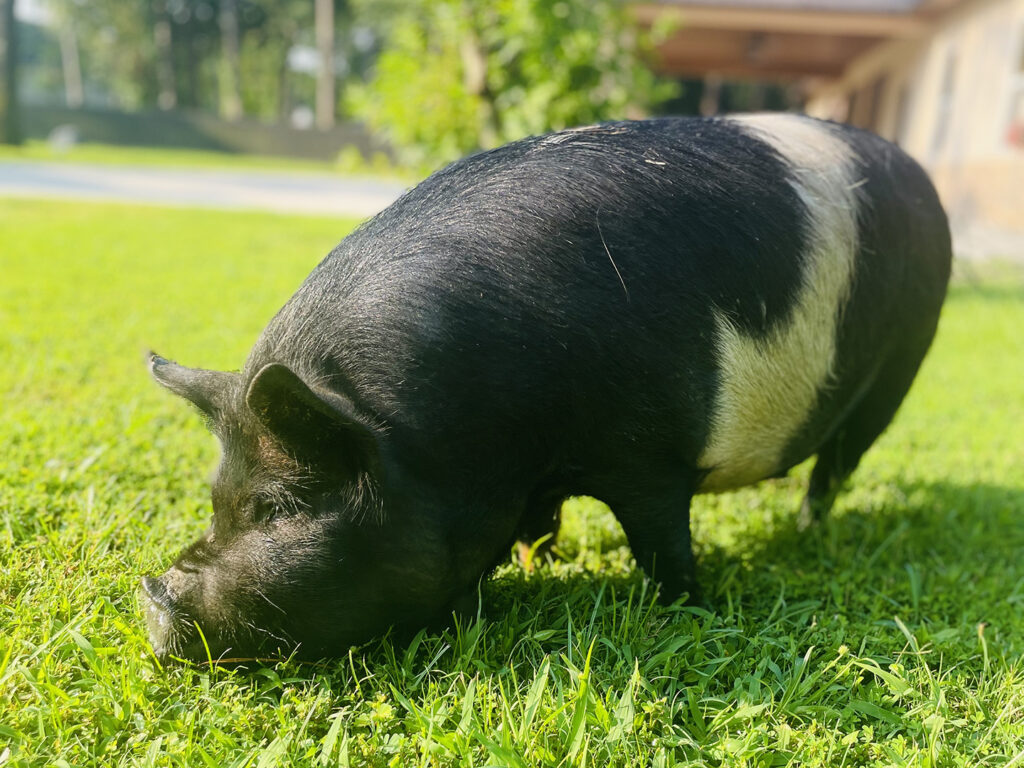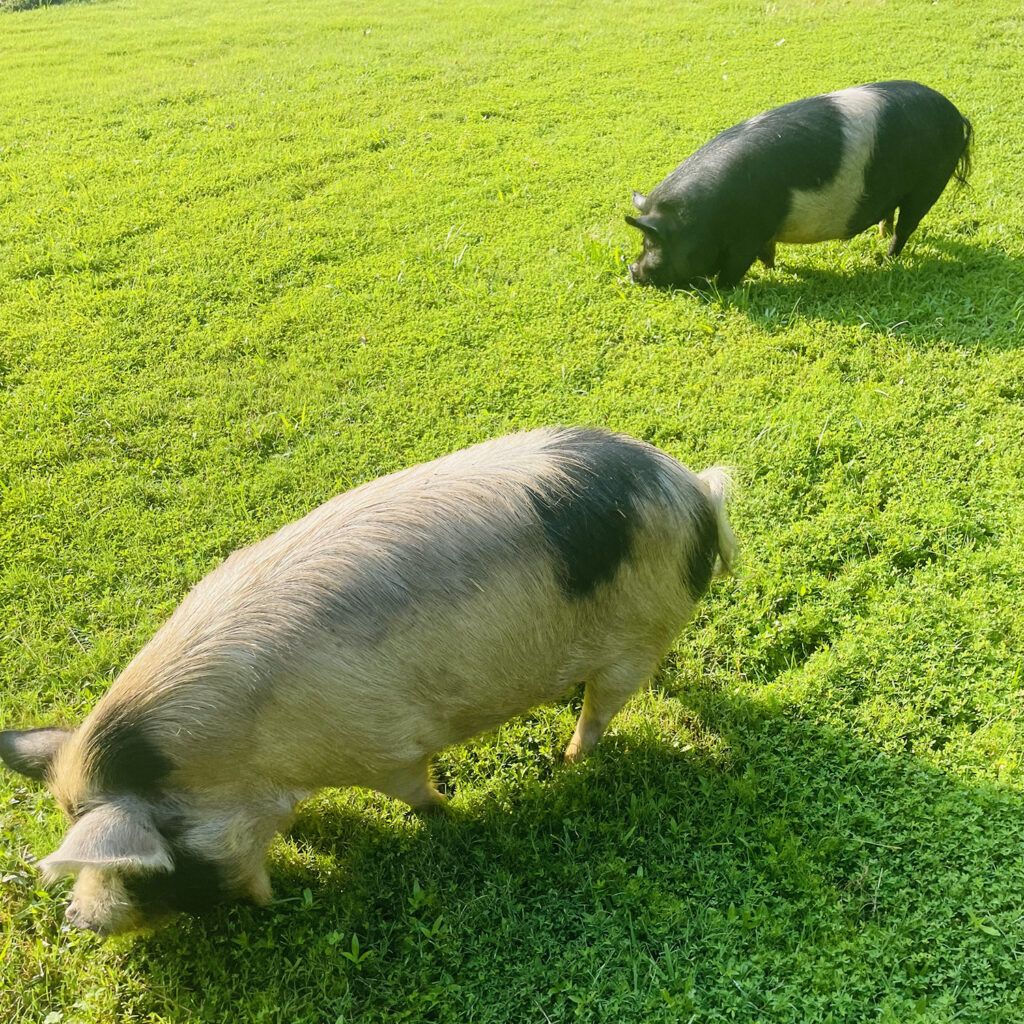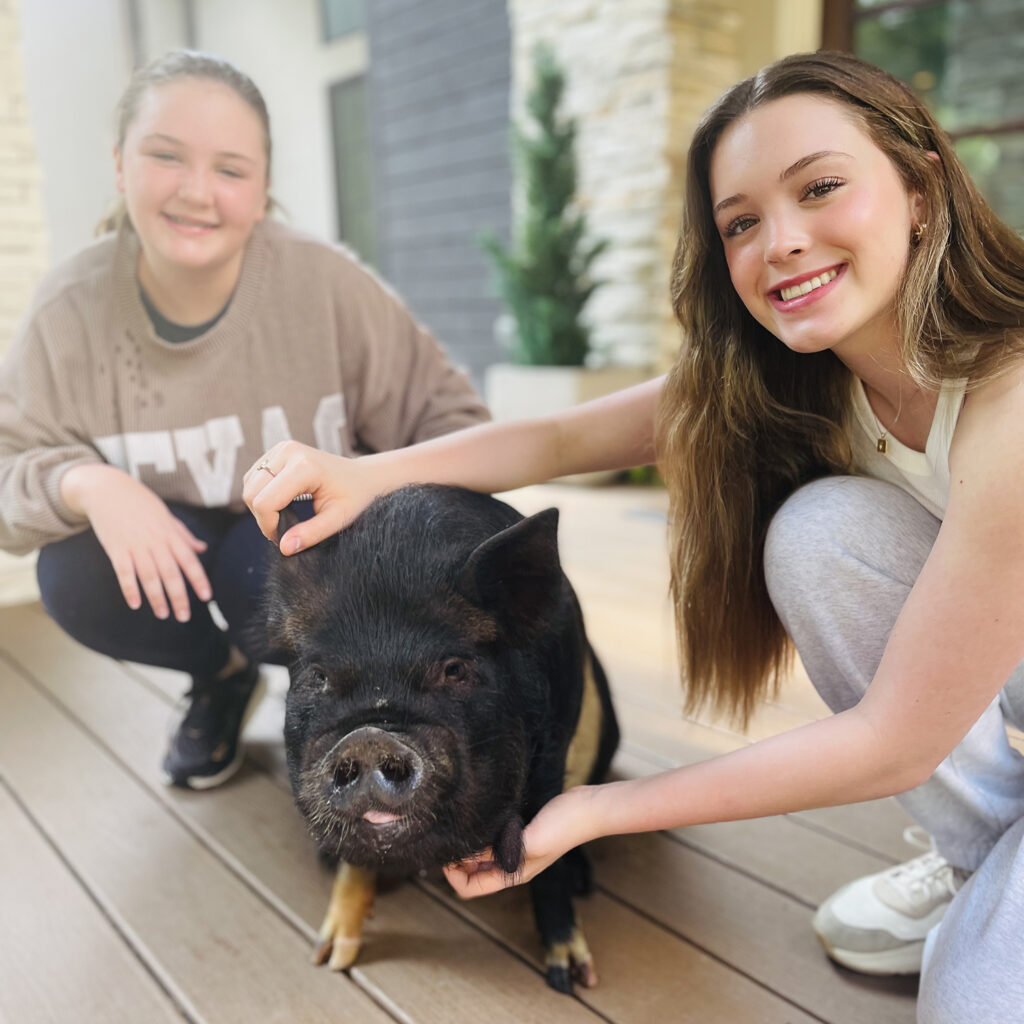Texas A&M Large Animal Hospital Helps Pig Achieve Royal Recovery
Story by Michaela Dunn, VMBS Marketing & Communications

With help from the university’s veterinary team, a pig named King Louie overcame a life-threatening disease.
In the classic tale of “Charlotte’s Web,” a pig named Wilbur captures hearts with his friendship and bravery. While not everyone gets to experience life with a swine of their own, the Ballard family knows what it’s like to fall head over heels for “some pig.”
King Louie — a 1-year-old KuneKune that joined the Ballard family with his brother, Lord Farquad — quickly stole the hearts of his owners Kristan Ballard, founder of the Texas Academy of Dance Arts, and her two daughters.
When Ballard noticed King Louie was ill, she quickly had him assessed by her local veterinarian, who referred him to the Texas A&M Large Animal Teaching Hospital (LATH) for what appeared to be a blockage of his intestines but turned out to be a serious infection. Thanks to the collaborative efforts of the LATH, King Louie is back to ruling his family’s hearts and home.
A Royal Connection
Inspired by Charlotte’s Web, Ballard and her daughters dreamed of owning a pet pig for as long as they could remember. When the family purchased a home on just over 2 acres of land, the dream became a reality.
“Lord Farquad was named after the silly little king in Shrek the musical, so it was fitting to name his brother after King Louis XIV, the patron of the arts,” Ballard said.
King Louie and Lord Farquad spend their days grazing the property, snacking on vegetables and soaking in the pool. But in May, when King Louie lost interest in his normal activities, Ballard immediately knew something was very wrong.

“He just wasn’t acting like his normal outgoing self at all,” she said. “He was walking around the yard; he wasn’t grazing. He would stop for long periods of time and then start lying down and not getting up.”
Ballard took him to her regular veterinarian, where X-rays were taken, and then he was referred to the LATH for more specialized care.
“They explained that he was really sick, and we needed to get him to A&M quickly,” Ballard said. “Our veterinarian set it all up for us; they made sure that we were able to get there quickly and that A&M knew it was urgent.”
Teamwork Makes The Dream Work
Friday evening, upon arrival at the LATH, King Louie was lethargic, anorexic, and had an extremely high fever, landing him in the Intensive Care Unit (ICU). Weekends in the ICU include clinicians from different specialty areas urgently working together to evaluate patients so treatment can be administered as soon as possible.
The team drew blood, placed IVs, and tested for a possible blockage of the large or small intestine.
After King Louie was evaluated, the Food Animal Medicine surgery team ordered a complete white blood cell count and a blood chemistry panel to determine the state of King Louie’s major organ systems.
“Our results indicated that he had red blood cells in his abdomen and a severe bacterial infection in his bloodstream,” said Dr. Kevin Washburn, a professor at the Texas A&M College of Veterinary Medicine and Biomedical Sciences.
Ultimately, King Louie was diagnosed with erysipelas, a bacterial infection that can be fatal if left untreated. Because the disease is characterized by diamond-shaped lesions, it is more commonly known as diamond skin disease.
“Over the course of hospitalization, King Louie began to develop the typical diamond-shaped skin lesions; however, aggressive antibiotic therapy stopped their development, and they started to disappear as his condition improved,” Washburn said. “If the infection had not been caught early, the progression most likely would have led to damage to major organs such as the kidney and liver, leading to failure.

As the team provided round-the-clock care to combat King Louie’s infection, Ballard said it was a relief to know their beloved pig was in good hands and receiving compassionate care.
“It was 24-hour care for this sweet pig; they sent us pictures and there were regular updates and phone calls,” Ballard said. “They really were committed to saving his life because he was going to die. King Louie was truly treated like a king.”
While King Louie was responding well to treatment, he was missing his brother, Lord Farquad, who was eagerly waiting for his return home.
“Lord Farquad was just running around not knowing even what to do because King Louie wasn’t there for a few days,” Ballard said.
After a weekend of aggressive treatments, Washburn sent King Louie home to recover, but he had to remain isolated for a few more days until his treatments were complete.
Now, King Louie is fully recovered and back to ruling the Ballard household alongside Lord Farquad.
“We were so worried and scared, but at the same time, we were full of hope because we knew that he was in the best hands in the state of Texas,” Ballard said. “We are just so deeply grateful for Texas A&M saving his life; I 100% would recommend Texas A&M to anyone with any animal.”
###
For more information about the Texas A&M College of Veterinary Medicine & Biomedical Sciences, please visit our website at vetmed.tamu.edu or join us on Facebook, Instagram, and Twitter.
Contact Information: Jennifer Gauntt, Director of VMBS Communications, Texas A&M College of Veterinary Medicine & Biomedical Sciences, jgauntt@cvm.tamu.edu, 979-862-4216


